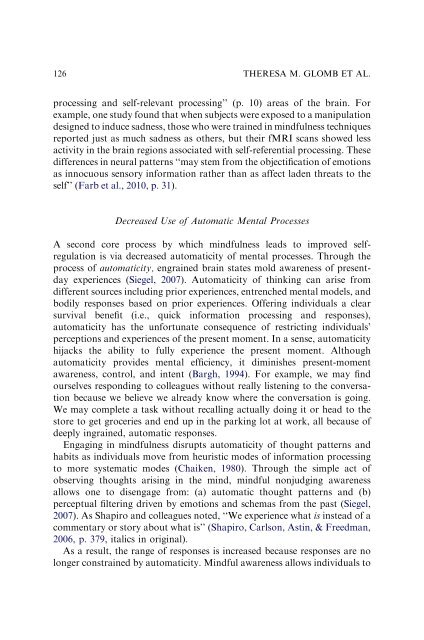Mindfulness at work (Glomb, Duffy et al, 2012) - Human Resources
Mindfulness at work (Glomb, Duffy et al, 2012) - Human Resources
Mindfulness at work (Glomb, Duffy et al, 2012) - Human Resources
You also want an ePaper? Increase the reach of your titles
YUMPU automatically turns print PDFs into web optimized ePapers that Google loves.
126THERESA M. GLOMB ET AL.processing and self-relevant processing’’ (p. 10) areas of the brain. Forexample, one study found th<strong>at</strong> when subjects were exposed to a manipul<strong>at</strong>iondesigned to induce sadness, those who were trained in mindfulness techniquesreported just as much sadness as others, but their fMRI scans showed lessactivity in the brain regions associ<strong>at</strong>ed with self-referenti<strong>al</strong> processing. Thesedifferences in neur<strong>al</strong> p<strong>at</strong>terns ‘‘may stem from the objectific<strong>at</strong>ion of emotionsas innocuous sensory inform<strong>at</strong>ion r<strong>at</strong>her than as affect laden thre<strong>at</strong>s to theself’’ (Farb <strong>et</strong> <strong>al</strong>., 2010, p. 31).Decreased Use of Autom<strong>at</strong>ic Ment<strong>al</strong> ProcessesA second core process by which mindfulness leads to improved selfregul<strong>at</strong>ionis via decreased autom<strong>at</strong>icity of ment<strong>al</strong> processes. Through theprocess of autom<strong>at</strong>icity, engrained brain st<strong>at</strong>es mold awareness of presentdayexperiences (Siegel, 2007). Autom<strong>at</strong>icity of thinking can arise fromdifferent sources including prior experiences, entrenched ment<strong>al</strong> models, andbodily responses based on prior experiences. Offering individu<strong>al</strong>s a clearsurviv<strong>al</strong> benefit (i.e., quick inform<strong>at</strong>ion processing and responses),autom<strong>at</strong>icity has the unfortun<strong>at</strong>e consequence of restricting individu<strong>al</strong>s’perceptions and experiences of the present moment. In a sense, autom<strong>at</strong>icityhijacks the ability to fully experience the present moment. Althoughautom<strong>at</strong>icity provides ment<strong>al</strong> efficiency, it diminishes present-momentawareness, control, and intent (Bargh, 1994). For example, we may findourselves responding to colleagues without re<strong>al</strong>ly listening to the convers<strong>at</strong>ionbecause we believe we <strong>al</strong>ready know where the convers<strong>at</strong>ion is going.We may compl<strong>et</strong>e a task without rec<strong>al</strong>ling actu<strong>al</strong>ly doing it or head to thestore to g<strong>et</strong> groceries and end up in the parking lot <strong>at</strong> <strong>work</strong>, <strong>al</strong>l because ofdeeply ingrained, autom<strong>at</strong>ic responses.Engaging in mindfulness disrupts autom<strong>at</strong>icity of thought p<strong>at</strong>terns andhabits as individu<strong>al</strong>s move from heuristic modes of inform<strong>at</strong>ion processingto more system<strong>at</strong>ic modes (Chaiken, 1980). Through the simple act ofobserving thoughts arising in the mind, mindful nonjudging awareness<strong>al</strong>lows one to disengage from: (a) autom<strong>at</strong>ic thought p<strong>at</strong>terns and (b)perceptu<strong>al</strong> filtering driven by emotions and schemas from the past (Siegel,2007). As Shapiro and colleagues noted, ‘‘We experience wh<strong>at</strong> is instead of acommentary or story about wh<strong>at</strong> is’’ (Shapiro, Carlson, Astin, & Freedman,2006, p. 379, it<strong>al</strong>ics in origin<strong>al</strong>).As a result, the range of responses is increased because responses are nolonger constrained by autom<strong>at</strong>icity. Mindful awareness <strong>al</strong>lows individu<strong>al</strong>s to


